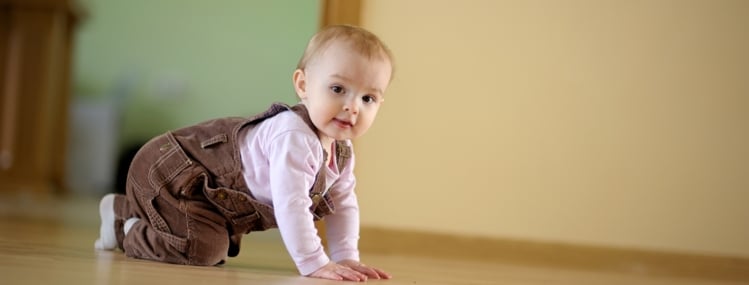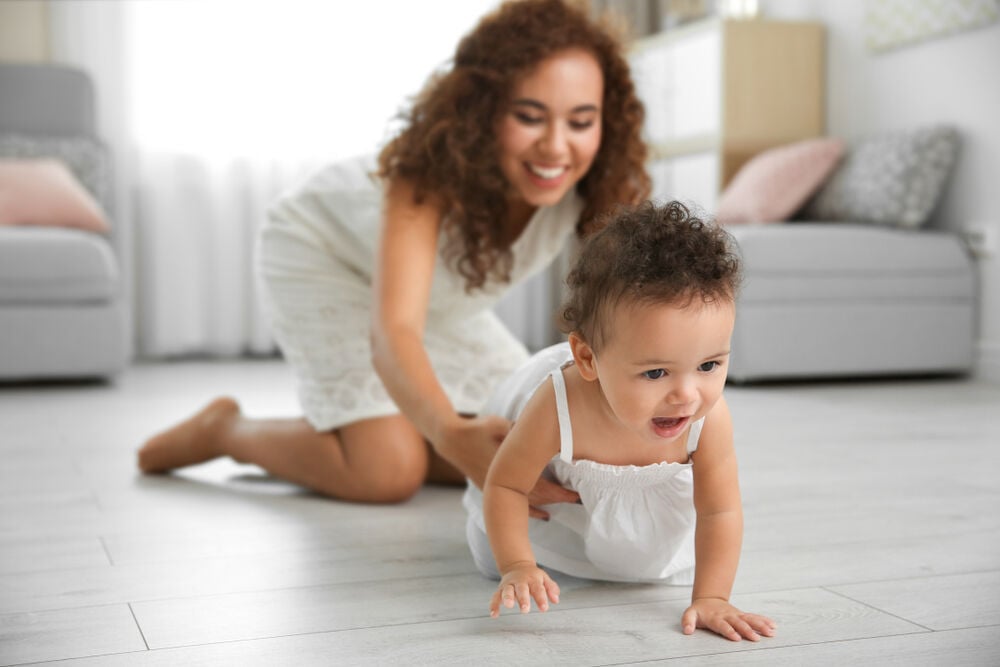If you’re like most parents, you’re probably pretty eager to see your little one starting to crawl. If you feel that your baby is on the cusp of becoming mobile, Flo’s complete guide to crawling is for you.
-
Tracking cycle
-
Getting pregnant
-
Pregnancy
-
Help Center
-
Flo for Partners
-
Anonymous Mode
-
Flo app reviews
-
Flo Premium New
-
Secret Chats New
-
Symptom Checker New
-
Your cycle
-
Health 360°
-
Getting pregnant
-
Pregnancy
-
Being a mom
-
LGBTQ+
-
Quizzes
-
Ovulation calculator
-
hCG calculator
-
Pregnancy test calculator
-
Menstrual cycle calculator
-
Period calculator
-
Implantation calculator
-
Pregnancy weeks to months calculator
-
Pregnancy due date calculator
-
IVF and FET due date calculator
-
Due date calculator by ultrasound
-
Medical Affairs
-
Science & Research
-
Pass It On Project New
-
Privacy Portal
-
Press Center
-
Flo Accuracy
-
Careers
-
Contact Us
When do babies start crawling? Understanding a significant milestone


Every piece of content at Flo Health adheres to the highest editorial standards for language, style, and medical accuracy. To learn what we do to deliver the best health and lifestyle insights to you, check out our content review principles.
When should baby crawl?
Crawling is a big deal for most parents. After all, it’s the first sign that your infant is now mobile. Some babies start to show signs of movement when they shuffle around on their tummies, which is known as creeping. From this point, it’s not long before your little one will be on all fours and blazing a trail through your home!
While babies vary widely in how quickly they start to crawl, it’s often helpful for parents to have a typical timeline that gives them some idea of what to expect. Many infants start to learn to crawl around 7 months of age, and most are fully crawling by 9 months. This means that at one year old, your little one should be quite mobile and comfortable with exploring the outside world.
Having said all this, it’s worth reiterating that each child develops at their own pace. As a parent, you should be careful not to be too rigid in how you expect your baby to develop. Rather than helping with the process, this is likely to create unnecessary worry for yourself and other caregivers.
While some infants follow the classical pattern of sitting, crawling, then walking, others graduate directly from bottom-shuffling to walking. Still, others may pull themselves into a standing position and start walking without ever having crawled! The most important thing is that your baby starts moving — not how they do so.
I got Flo last year in hopes of getting pregnant again after 15 years and me being 37, so I entered my stuff in and it told me when I was most fertile! And just after 2 months of using this app I was pregnant! Now I have a healthy baby girl, and using the app again to try for another baby! Get the app if you want to get pregnant!
How babies learn to crawl
At around 6 or 7 months, you’ll notice your baby starting to move around a little on their tummy. This precursor to crawling is an important part of the process, and time spent on the tummy gives your little one the opportunity to strengthen his or her arms and legs in preparation for crawling. By the end of this stage, an infant will be able to raise their head and chest off the ground while supported by their arms.
After this, your baby will probably begin to creep — sometimes called ‘commando-crawling’ — by dragging themselves forward on their forearms. They may then progress to lifting themselves onto all fours and rocking forwards and backwards, with their arms straight and their body parallel to the floor. By 7 months, your little one may be able to sit unaided — and now that their arm, leg, and back muscles are more developed, they’ll comfortably support themselves on all fours.
Over the next 2 or 3 months, your baby will gradually start to learn that pushing off with their legs will give them momentum to move forwards. In the early stages of crawling, they may go backwards before developing the coordination to move in the right direction. Around this time, your little one will also learn to move from crawling to sitting positions and vice versa with greater ease.
Along with sitting unsupported and crawling, an infant at this stage of development begins to experiment with pulling themselves into a standing position and holding it for a short time. At 9 months, this should be a well-developed skill — even if they still topple from time to time!
By one year old, your baby should be crawling comfortably and confidently around your home and the outside world.
Babies crawling: How can parents help?

Take a quiz
Find out what you can do with our Health Assistant
Babies normally develop crawling skills perfectly well on their own, even without outside support. But there are a few things you can do to nudge your little one in the right direction.
- The key to crawling is encouraging your baby to spend time on their tummy. Start with a few minutes and then build up to longer periods, but always make sure your little one is awake and completely alert and don’t leave them unattended.
- You can start putting your baby on their tummy soon after they’re born, but in the early stages you may want to do this in your arms or on your chest rather than on the floor.
- At around 3 or 4 months, start to increase tummy time on the floor. You can encourage mobility by placing toys or other baby-safe items just out of reach so your baby is coaxed into movement.
What to do if your baby doesn’t crawl
Concerns about delayed crawling are a common worry for many parents. This can be particularly troubling if the children of friends or relatives, or even older siblings, started to crawl at an earlier age. But many of these anxieties are the result of an unnecessary fixation upon the style of crawling that a baby has adopted, rather than any genuine developmental problem.
There are many different ways for a baby to crawl, and pediatricians don’t regard any one as superior to the others. Sometimes a variety of baby-crawling exercises can be used to help. For example, in an assisted crawling exercise you take a towel and fold it over a few times lengthwise, then have baby lay on top it. Lift either side of the towel so that baby’s chest is resting on top of it but is off the ground, lifting his or her chest and belly upward as the arms and legs dangle toward the ground.
Here’s the bottom line when it comes to crawling: as long as your baby is getting around and exploring the world, it really doesn’t matter what type of crawling they favor. So whether your little one prefers to creep or move around on his or her belly, you can rest assured that they are developing normally.
In most cases, creeping on the belly is a precursor to crawling on hands and knees, although some infants never crawl on all fours. Some babies start to crawl (or creep, as the case may be) as early as 6 or 7 months old, but usually this doesn’t occur until nearer the 9-month mark or later. Late crawling is only ever a cause for concern when it occurs alongside other signs of developmental delay.
For instance, your pediatrician may wish to monitor your baby’s development if there is delay in learning to sit unaided. However, even in these cases, it is common for such concerns to prove unfounded when developmental milestones are eventually reached at a later point. Some babies will crawl backwards or sideways many weeks before they learn how to move forwards. Others shuffle on their bottom or travel on hands and feet before ultimately starting to walk.
So, if you’re an anxious parent who’s eagerly waiting for your little one to start crawling, let things take their course and your baby will be crawling around before you know it. But do let your pediatrician know if you become concerned that your child doesn’t seem to be using the arms and legs on both sides of their body equally.


Hey, I'm Anique
I started using Flo app to track my period and ovulation because we wanted to have a baby.


The Flo app helped me learn about my body and spot ovulation signs during our conception journey.


I vividly
remember the day
that we switched
Flo into
Pregnancy Mode — it was
such a special
moment.
Real stories, real results
Learn how the Flo app became an amazing cheerleader for us on our conception journey.




